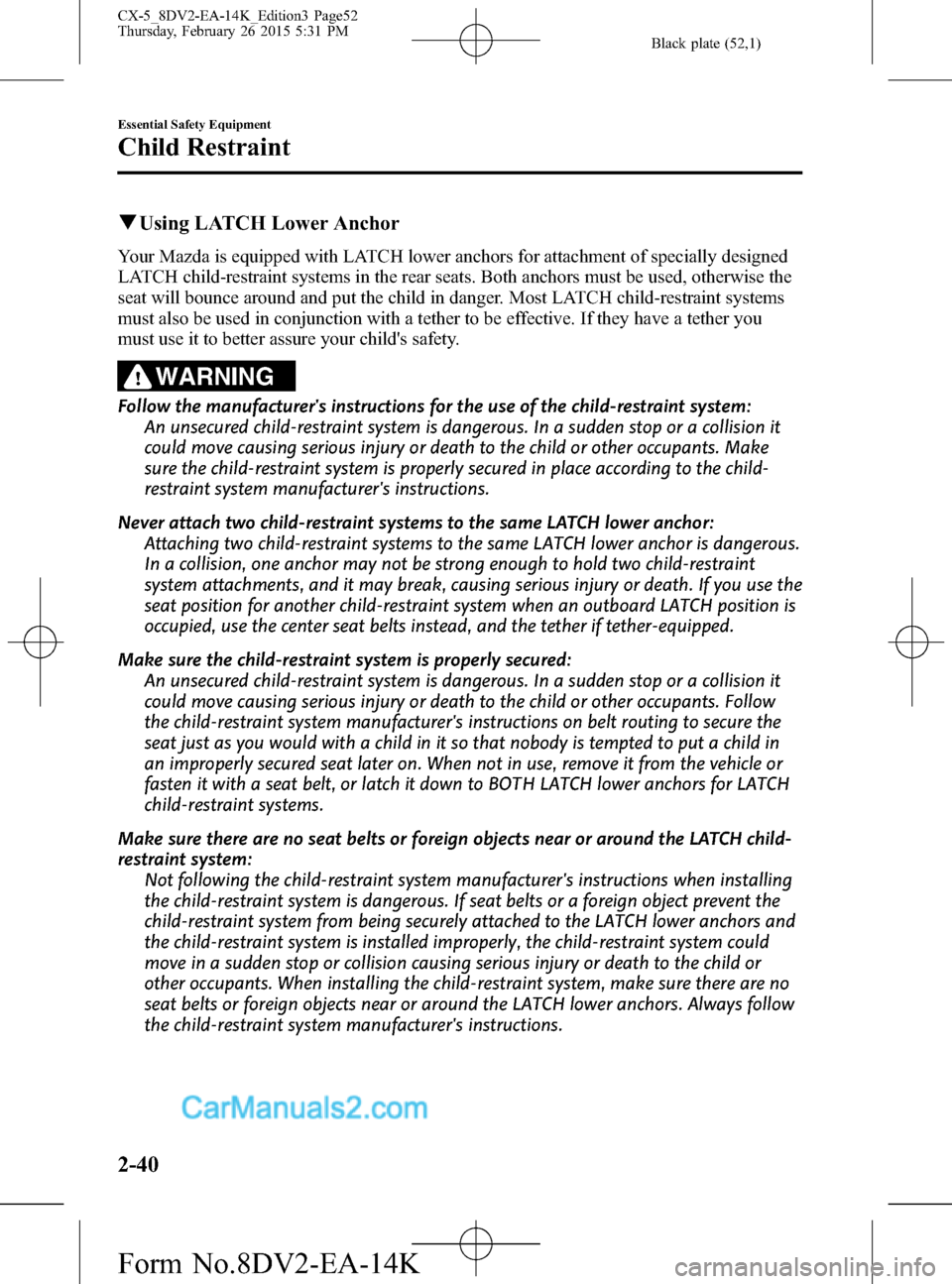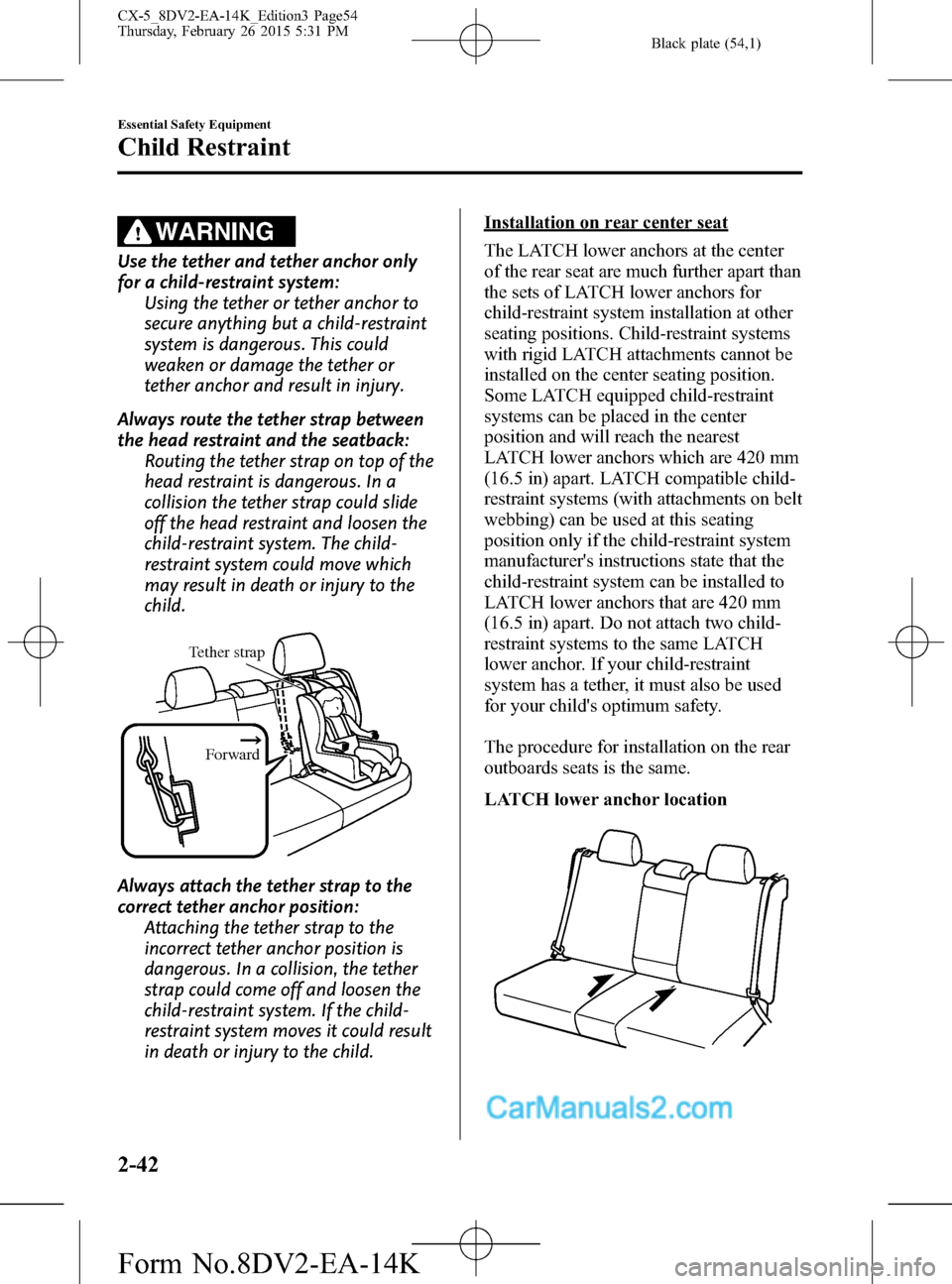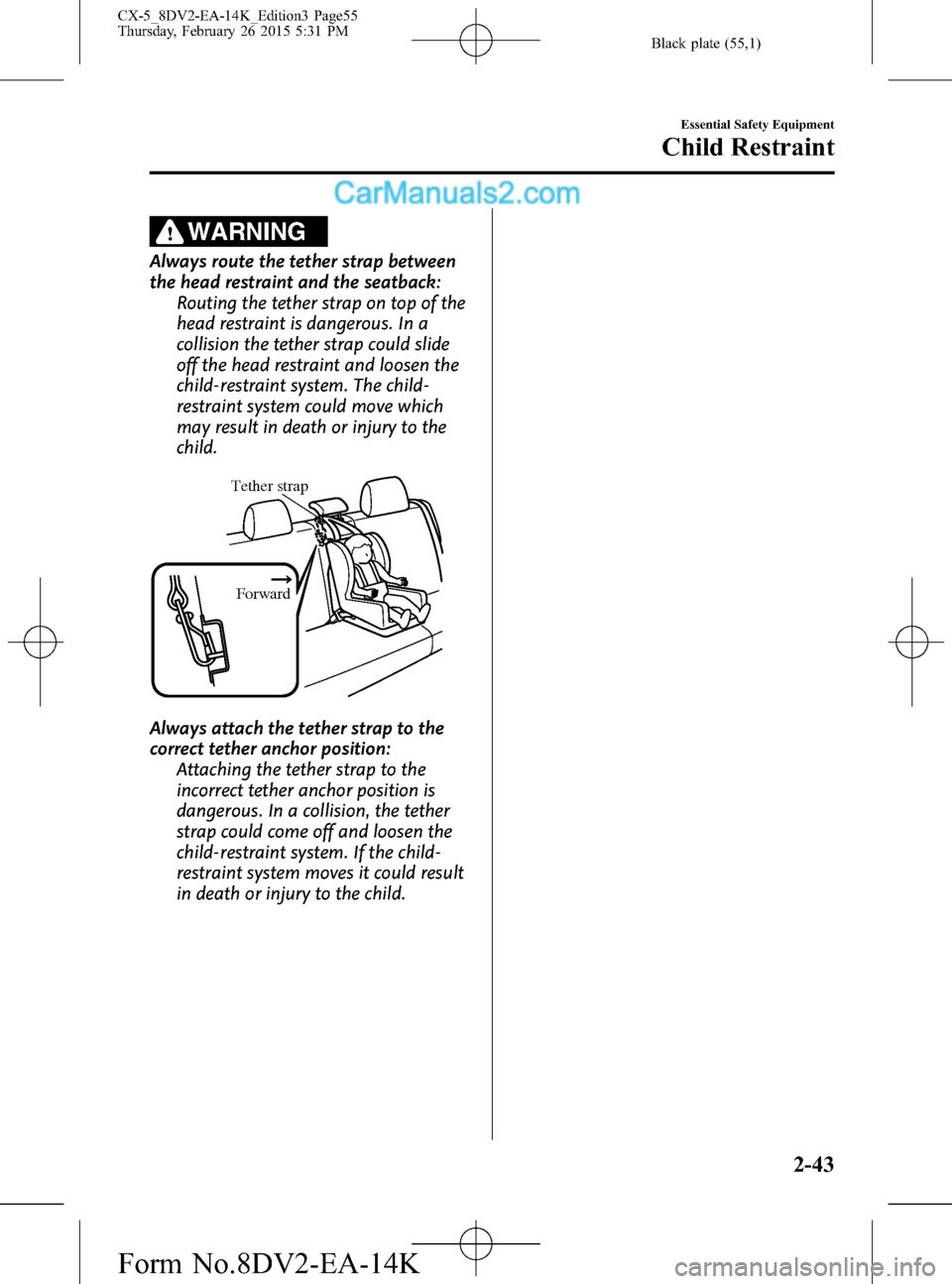warning MAZDA MODEL CX-5 2016 (in English) Owner's Manual
[x] Cancel search | Manufacturer: MAZDA, Model Year: 2016, Model line: MODEL CX-5, Model: MAZDA MODEL CX-5 2016Pages: 626, PDF Size: 13.81 MB
Page 51 of 626

Black plate (51,1)
WARNING
Do not seat a child in a child-restraint
system on the front passenger seat if
the front passenger air bag
deactivation indicator light does not
illuminate (With Front Passenger
Occupant Classification System):
While it is always better to install any
child-restraint system on the rear
seat, it is imperative that a child-
restraint systemONLYbe used on the
front passenger seat if the
deactivation indicator light
illuminates when the child is seated
in the child-restraint system (page
2-60). Seating a child in a child-
restraint system installed on the front
passenger seat with the front
passenger air bag deactivation
indicator light not illuminated is
dangerous. If this indicator light does
not illuminate, this means that the
front passenger front and side air
bags, and seat belt pretensioner are
ready for deployment. If an accident
were to deploy an air bag, a child in
a child-restraint system sitting in the
front passenger seat could be
seriously injured or killed. If the
indicator light does not illuminate
after seating a child in a child-
restraint system on the front
passenger seat, seat a child in a
child-restraint system on the rear
seat and consult an Authorized
Mazda Dealer as soon as possible.
Essential Safety Equipment
Child Restraint
2-39
CX-5_8DV2-EA-14K_Edition3 Page51
Thursday, February 26 2015 5:31 PM
Form No.8DV2-EA-14K
Page 52 of 626

Black plate (52,1)
qUsing LATCH Lower Anchor
Your Mazda is equipped with LATCH lower anchors for attachment of specially designed
LATCH child-restraint systems in the rear seats. Both anchors must be used, otherwise the
seat will bounce around and put the child in danger. Most LATCH child-restraint systems
must also be used in conjunction with a tether to be effective. If they have a tether you
must use it to better assure your child's safety.
WARNING
Follow the manufacturer's instructions for the use of the child-restraint system:
An unsecured child-restraint system is dangerous. In a sudden stop or a collision it
could move causing serious injury or death to the child or other occupants. Make
sure the child-restraint system is properly secured in place according to the child-
restraint system manufacturer's instructions.
Never attach two child-restraint systems to the same LATCH lower anchor:
Attaching two child-restraint systems to the same LATCH lower anchor is dangerous.
In a collision, one anchor may not be strong enough to hold two child-restraint
system attachments, and it may break, causing serious injury or death. If you use the
seat position for another child-restraint system when an outboard LATCH position is
occupied, use the center seat belts instead, and the tether if tether-equipped.
Make sure the child-restraint system is properly secured:
An unsecured child-restraint system is dangerous. In a sudden stop or a collision it
could move causing serious injury or death to the child or other occupants. Follow
the child-restraint system manufacturer's instructions on belt routing to secure the
seat just as you would with a child in it so that nobody is tempted to put a child in
an improperly secured seat later on. When not in use, remove it from the vehicle or
fasten it with a seat belt, or latch it down to BOTH LATCH lower anchors for LATCH
child-restraint systems.
Make sure there are no seat belts or foreign objects near or around the LATCH child-
restraint system:
Not following the child-restraint system manufacturer's instructions when installing
the child-restraint system is dangerous. If seat belts or a foreign object prevent the
child-restraint system from being securely attached to the LATCH lower anchors and
the child-restraint system is installed improperly, the child-restraint system could
move in a sudden stop or collision causing serious injury or death to the child or
other occupants. When installing the child-restraint system, make sure there are no
seat belts or foreign objects near or around the LATCH lower anchors. Always follow
the child-restraint system manufacturer's instructions.
2-40
Essential Safety Equipment
Child Restraint
CX-5_8DV2-EA-14K_Edition3 Page52
Thursday, February 26 2015 5:31 PM
Form No.8DV2-EA-14K
Page 54 of 626

Black plate (54,1)
WARNING
Use the tether and tether anchor only
for a child-restraint system:
Using the tether or tether anchor to
secure anything but a child-restraint
system is dangerous. This could
weaken or damage the tether or
tether anchor and result in injury.
Always route the tether strap between
the head restraint and the seatback:
Routing the tether strap on top of the
head restraint is dangerous. In a
collision the tether strap could slide
off the head restraint and loosen the
child-restraint system. The child-
restraint system could move which
may result in death or injury to the
child.
Tether strap
Forward
Always attach the tether strap to the
correct tether anchor position:
Attaching the tether strap to the
incorrect tether anchor position is
dangerous. In a collision, the tether
strap could come off and loosen the
child-restraint system. If the child-
restraint system moves it could result
in death or injury to the child.
Installation on rear center seat
The LATCH lower anchors at the center
of the rear seat are much further apart than
the sets of LATCH lower anchors for
child-restraint system installation at other
seating positions. Child-restraint systems
with rigid LATCH attachments cannot be
installed on the center seating position.
Some LATCH equipped child-restraint
systems can be placed in the center
position and will reach the nearest
LATCH lower anchors which are 420 mm
(16.5 in) apart. LATCH compatible child-
restraint systems (with attachments on belt
webbing) can be used at this seating
position only if the child-restraint system
manufacturer's instructions state that the
child-restraint system can be installed to
LATCH lower anchors that are 420 mm
(16.5 in) apart. Do not attach two child-
restraint systems to the same LATCH
lower anchor. If your child-restraint
system has a tether, it must also be used
for your child's optimum safety.
The procedure for installation on the rear
outboards seats is the same.
LATCH lower anchor location
2-42
Essential Safety Equipment
Child Restraint
CX-5_8DV2-EA-14K_Edition3 Page54
Thursday, February 26 2015 5:31 PM
Form No.8DV2-EA-14K
Page 55 of 626

Black plate (55,1)
WARNING
Always route the tether strap between
the head restraint and the seatback:
Routing the tether strap on top of the
head restraint is dangerous. In a
collision the tether strap could slide
off the head restraint and loosen the
child-restraint system. The child-
restraint system could move which
may result in death or injury to the
child.
Tether strap
Forward
Always attach the tether strap to the
correct tether anchor position:
Attaching the tether strap to the
incorrect tether anchor position is
dangerous. In a collision, the tether
strap could come off and loosen the
child-restraint system. If the child-
restraint system moves it could result
in death or injury to the child.
Essential Safety Equipment
Child Restraint
2-43
CX-5_8DV2-EA-14K_Edition3 Page55
Thursday, February 26 2015 5:31 PM
Form No.8DV2-EA-14K
Page 57 of 626

Black plate (57,1)
If your vehicle is also equipped with a front passenger occupant classification system,
refer to the Front Passenger Occupant Classification System (page 2-60) for details.
If your vehicle is equipped with a front passenger occupant classification system, the front
passenger air bag deactivation indicator light illuminates for a specified time after the
ignition is switched ON.
Climate control
Fully Automatic
Type
Manual Type
Small children must be protected by a child-restraint system as stipulated by law in every
state and province. In certain states and provinces, larger children must use a child-restraint
system (page 2-26).
Carefully consider which child-restraint system is necessary for your child and follow the
installation directions in this Owner's Manual as well as the child-restraint system
manufacturer's instructions.
WARNING
Seat belts must be worn in air bag equipped vehicles:
Depending only on the air bags for protection during an accident is dangerous.
Alone, air bags may not prevent serious injuries. The appropriate air bags can be
expected to inflate only in the first accident, such as frontal, near frontal or side
collisions or roll-over accident that are at least moderate. Vehicle occupants should
always wear seat belts.
Children should not ride in the front passenger seat:
Placing a child, 12 years or under, in the front seat is dangerous. The child could be
hit by a deploying air bag and be seriously injured or even killed. A sleeping child is
more likely to lean against the door and be hit by the side air bag in moderate
collision to the front-passenger side of the vehicle. Whenever possible, always secure
a child 12 years and under on the rear seats with an appropriate child-restraint
system for the child's age and size.
Essential Safety Equipment
SRS Air Bags
2-45
CX-5_8DV2-EA-14K_Edition3 Page57
Thursday, February 26 2015 5:31 PM
Form No.8DV2-EA-14K
Page 64 of 626

Black plate (64,1)
Without front passenger occupant classification system
Driver/Front passenger inflators and air bags
Roll-over sensorí, crash sensors, and diagnostic module (SAS unit)
Front seat belt pretensioners (page 2-21)
Front air bag sensors
Side crash sensors
Air bag/front seat belt pretensioner system warning light (page 4-20)
Side and curtain inflators and air bags
Front passenger air bag deactivation indicator light (page 2-60)
Front passenger occupant classification sensor (page 2-60)
Front passenger occupant classification module
2-52
Essential Safety Equipment
íSome models.
SRS Air Bags
CX-5_8DV2-EA-14K_Edition3 Page64
Thursday, February 26 2015 5:31 PM
Form No.8DV2-EA-14K
Page 68 of 626

Black plate (68,1)
(With Front Passenger Occupant Classification System)
In a roll-over:
In response to a vehicle roll-over, both curtain air bags inflate.
Both curtain air bags will deploy after
the roll-over accident is detected.
qWarning Light/Beep
A system malfunction or operation conditions are indicated by a warning.
Refer to Warning/Indicator Lights on page 4-20.
Refer to Air Bag/Front Seat Belt Pretensioner System Warning Beep on page 7-35.
2-56
Essential Safety Equipment
SRS Air Bags
CX-5_8DV2-EA-14K_Edition3 Page68
Thursday, February 26 2015 5:31 PM
Form No.8DV2-EA-14K
Page 72 of 626

Black plate (72,1)
Front Passenger Occupant Classification Systemí
First, please read“Supplemental Restraint System (SRS) Precautions”(page 2-44)
carefully.
qFront Passenger Occupant Classification Sensor
Your vehicle is equipped with a front passenger occupant classification sensor as a part of
the supplemental restraint system. This sensor is equipped in the front passenger's seat
cushion. This sensor measures the electrostatic capacity of the front passenger's seat. The
SAS unit is designed to prevent the front passenger front and side air bags and seat belt
pretensioner system from deploying if the front passenger air bag deactivation indicator
light turns on.
To reduce the chance of injuries caused by deployment of the front passenger air bag, the
system deactivates the front passenger front and side air bags and also the seat belt
pretensioner system when the front passenger air bag deactivation indicator light turns on.
Refer to the following table for the front passenger air bag deactivation indicator light
illumination conditions.
This system shuts off the front passenger front and side air bags and seat belt pretensioner
system, so make sure the front passenger air bag deactivation indicator light turns on
according to the following table.
The air bag/front seat belt pretensioner system warning light flashes and the front
passenger air bag deactivation indicator light illuminates if the sensors have a possible
malfunction. If this happens, the front passenger front and side air bags and seat belt
pretensioner system will not deploy.
2-60
Essential Safety Equipment
íSome models.
SRS Air Bags
CX-5_8DV2-EA-14K_Edition3 Page72
Thursday, February 26 2015 5:32 PM
Form No.8DV2-EA-14K
Page 74 of 626

Black plate (74,1)
The curtain air bag is ready for inflating regardless of what the front passenger air bag
deactivation indicator light on/off condition chart indicates.
If the front passenger air bag deactivation indicator light does not turn on when the ignition
is switched ON and does not turn on as indicated in the front passenger air bag deactivation
indicator light on/off condition chart, do not allow an occupant to sit in the front passenger
seat and consult an Authorized Mazda Dealer as soon as possible. The system may not
work properly in an accident.
WARNING
Do not allow an occupant in the front passenger's seat to sit with a posture which
makes it difficult for the front passenger occupant classification sensor to detect the
occupant correctly:
Sitting in the front passenger's seat with a posture which makes it difficult for the
front passenger occupant classification sensor to detect the occupant correctly is
dangerous. If the front passenger occupant classification sensor cannot detect the
occupant sitting on the front passenger's seat correctly, the front passenger front
and side air bags and pretensioner system may not operate (deploy) or they may
operate (deploy) accidentally. The front passenger will not have the supplementary
protection of the air bags or the accidental operation (deployment) of the air bags
could result in serious injury or death.
Under the following conditions, the front passenger occupant classification sensor
cannot detect a passenger sitting on the front passenger's seat correctly and the
deployment/non-deployment of the air bags cannot be controlled as indicated in the
front passenger air bag deactivation indicator light on/off condition chart. For
example:
2-62
Essential Safety Equipment
SRS Air Bags
CX-5_8DV2-EA-14K_Edition3 Page74
Thursday, February 26 2015 5:32 PM
Form No.8DV2-EA-14K
Page 77 of 626

Black plate (77,1)
NOTElThe system requires about 10 seconds to alternate between turning the front passenger front and
side air bags and seat belt pretensioner system on or off.
lThe front passenger air bag deactivation indicator light may turn on repeatedly if luggage or
other items are put on the front passenger seat, or if the temperature of the vehicle's interior
changes suddenly.
lThe front passenger air bag deactivation indicator light may turn on for 10 seconds if the
electrostatic capacity on the front passenger seat changes.
lThe air bag/front seat belt pretensioner system warning light might turn on if the front passenger
seat receives a severe impact.
lIf the front passenger air bag deactivation indicator light does not turn on after installing a child-
restraint system on the front passenger seat, first, re-install your child-restraint system according
to the procedure in this owner's manual. Then, if the front passenger air bag deactivation
indicator light still does not turn on, install the child-restraint system on the rear seat and consult
an Authorized Mazda Dealer as soon as possible.
lIf the front passenger air bag deactivation indicator light turns on when an occupant is seated
directly in the front passenger seat, have the passenger re-adjust their posture by sitting with their
feet on the floor, and then re-fastening the seat belt. If the front passenger air bag deactivation
indicator light remains turned on, move the passenger to the rear seat. If sitting in the rear seat is
not possible, slide the front passenger seat as far back as possible. Consult an Authorized Mazda
Dealer as soon as possible.
Essential Safety Equipment
SRS Air Bags
2-65
CX-5_8DV2-EA-14K_Edition3 Page77
Thursday, February 26 2015 5:32 PM
Form No.8DV2-EA-14K